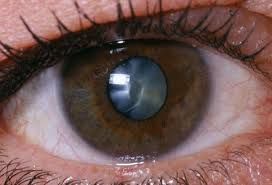What is cataract?
Cataract (‘सफेद मोतियाबिन्द‘) is a clouding or opacity of the normally transparent lens inside the eye. To understand why this leads to loss of vision, it is important to understand the functioning of a normal eye.
Inside the eye, behind the colored part of the eye (iris) with the black hole in the center (pupil) is a lens. In the normal eye the lens is clear or transparent. It helps to focus light rays on to the tissue at the back of the eye (retina). When cataract develops the lens becomes cloudy and prevents the light rays passing into the retina. The picture that the retina receives becomes dull and fuzzy. Cataract usually forms and progresses slowly and therefore leads to a gradual blurring of vision.

What causes cataract?
Most forms of cataract develop in adult life. The normal process of aging causes the lens to harden and become cloudy (opaque). This is called age-related cataract and it is the most common type. It can occur anytime after the age of 40. In younger people they can result from an injury, certain drugs, long-standing inflammation or illnesses such as diabetes. Babies can be born with this condition. This is called congenital cataract.
What are the symptoms of cataract?

-
-
-
- Blurring of Vision : Cataract leads to a painless, progressive blurring or dimming of vision. The things may seem blurred around the edges, or your glass may seem dirty or scratched. The opacity affecting the central part of the lens may cause poor vision in bright light.
- Frequent change of glasses : Some forms of cataract lead to a change in refractive power of your lens and thus cause frequent changes in power of your glasses. Because of this, some patients may no longer need the reading glasses for near work, this phenomenon is known as ‘second sight’.
- Glare : Cataract may also lead to sensitivity to light and glare, especially in bright sunlight or while driving at night.
- Double Images : The cloudiness in the lens may occur in more than one place, so that the light rays that reach the retina are split, causing a double image.
- Change in color vision : Cataract may also cause change in color vision. As the cataract develops its center becomes more and more yellow, giving everything you see a yellowish tinge.
-
-
